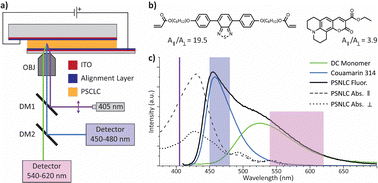The association of structural chirality and liquid crystal anchoring in polymer stabilized cholesteric liquid crystals†
Abstract
Polymer stabilized cholesteric liquid crystals (PSCLCs) are electrically reconfigurable reflective elements. Prior studies have hypothesized and indirectly confirmed that the electro-optic response of these composites is associated with the electrically mediated distortion of the stabilizing polymer network. The proposed mechanism is based on the retention of structural chirality in the polymer stabilizing network, which upon deformation is spatially distorted, which accordingly affects the pitch of the surrounding low molar-mass liquid crystal host. Here, we utilize fluorescent confocal polarized microscopy to directly assess the electro-optic response of PSCLCs. By utilizing dual fluorescent probes, sequential imaging experiments confirm that the periodicity of the polymer stabilizing network matches that of the low molar-mass liquid crystal host. Further, we isolate distinct ion-polymer interactions that manifest in certain photopolymerization conditions.



 Please wait while we load your content...
Please wait while we load your content...